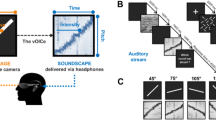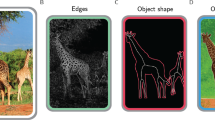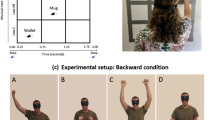Abstract
The lateral-occipital tactile-visual area (LOtv) is activated when objects are recognized by vision or touch. We report here that the LOtv is also activated in sighted and blind humans who recognize objects by extracting shape information from visual-to-auditory sensory substitution soundscapes. Recognizing objects by their typical sounds or learning to associate specific soundscapes with specific objects do not activate this region. This suggests that LOtv is driven by the presence of shape information.
This is a preview of subscription content, access via your institution
Access options
Subscribe to this journal
Receive 12 print issues and online access
$209.00 per year
only $17.42 per issue
Buy this article
- Purchase on Springer Link
- Instant access to full article PDF
Prices may be subject to local taxes which are calculated during checkout


Similar content being viewed by others
References
Hull, J.M. Touching the Rock: an Experience of Blindness (Vintage Books, New York, 1992).
Amedi, A., von Kriegstein, K., van Atteveldt, N.M., Beauchamp, M.S. & Naumer, M.J. Exp. Brain Res. 166, 559–571 (2005).
Beauchamp, M.S. Curr. Opin. Neurobiol. 15, 145–153 (2005).
Amedi, A., Malach, R., Hendler, T., Peled, S. & Zohary, E. Nat. Neurosci. 4, 324–330 (2001).
Bach-y-Rita, P. & Kersel, S.W. Trends Cogn. Sci. 7, 541–546 (2003).
Rauschecker, J.P. Trends Neurosci. 18, 36–43 (1995).
Meijer, P.B. IEEE Trans. Biomed. Eng. 39, 112–121 (1992).
Sathian, K. Dev. Psychobiol. 46, 279–286 (2005).
Collignon, O., Lassonde, M., Lepore, F., Bastien, D. & Veraart, C. Cereb. Cortex 17, 457–465 (2007).
Pascual-Leone, A., Amedi, A., Fregni, F. & Merabet, L.B. Annu. Rev. Neurosci. 28, 377–401 (2005).
Buchel, C., Price, C. & Friston, K. Nature 394, 274–2777 (1998).
Renier, L. et al. Neuroimage 26, 573–580 (2005).
Zangaladze, A., Epstein, C.M., Grafton, S.T. & Sathian, K. Nature 401, 587–590 (1999).
Ricciardi, E. et al. Cereb. Cortex published online 19 March 2007 (doi:10.1093/cercor/bhm018).
Pascual-Leone, A. & Hamilton, R. in Vision: From Neurons to Cognition, Progr. Brain Res (eds. Casanova, C. & Ptito, M.) Ch. 27 (Elsevier, New York, 2001).
Acknowledgements
We thank M. Thivierge for invaluable administrative help and S. Gautam for statistics support. The work on this article was supported by grants from the US National Institutes of Health (K24-RR018875, R21-EY0116168 and RO1-EY12091 to A.P.-L.) and The International Human Frontier Science Program Organization (to A.A).
Author information
Authors and Affiliations
Contributions
All authors were involved in the design and implementation of the study and the writing of the manuscript. A.P.-L. and A.A. devised the concept, A.A. carried out the analysis, W.M.S. designed and implemented the vOICe training program and P.M. provided expert technical support regarding The vOICe.
Corresponding authors
Ethics declarations
Competing interests
Peter Meijer is the inventor and holds a patent for 'The vOICe'.
Supplementary information
Supplementary Fig. 1
Schematic summary of the algorithm employed for the visuoauditory conversion and the components of the system (adapted from Meijer 1992). (PDF 210 kb)
Supplementary Fig. 2
Behavioral data from the scanner. (PDF 31 kb)
Supplementary Fig. 3
A conjunction analysis for shape across modalities and experimental conditions (similar to what was presented in Fig. 1c, adding the right hemisphere). (PDF 59 kb)
Supplementary Fig. 4
The magnitude of activation in LOtv across subjects for the right hemisphere. (PDF 65 kb)
Rights and permissions
About this article
Cite this article
Amedi, A., Stern, W., Camprodon, J. et al. Shape conveyed by visual-to-auditory sensory substitution activates the lateral occipital complex. Nat Neurosci 10, 687–689 (2007). https://doi.org/10.1038/nn1912
Received:
Accepted:
Published:
Issue Date:
DOI: https://doi.org/10.1038/nn1912
This article is cited by
-
Modulation of temporal and occipital cortex by acupuncture in non-menstrual MWoA patients: a rest BOLD fMRI study
BMC Complementary Medicine and Therapies (2024)
-
Learning and navigating digitally rendered haptic spatial layouts
npj Science of Learning (2023)
-
Effects of training and using an audio-tactile sensory substitution device on speech-in-noise understanding
Scientific Reports (2022)
-
Temporal visual representation elicits early auditory-like responses in hearing but not in deaf individuals
Scientific Reports (2022)
-
A computational examination of the two-streams hypothesis: which pathway needs a longer memory?
Cognitive Neurodynamics (2022)



